This article was published in Scientific American’s former blog network and reflects the views of the author, not necessarily those of Scientific American
One of the world’s most successful, diverse, abundant and widespread of lizard groups are the skinks, properly and conventionally called the Scincidae. This group contains over 1500 living species and accounts for about 25% of modern lizard diversity. Indeed, such is the size and diversity of this group that some authors think it should be elevated in status and renamed Scincomorpha*, its several constituent subgroups also being elevated to ‘family’ status (Hedges & Conn 2012; see also Pyron et al. 2013, Hedges 2014): I wrote about this issue in this skink-themed article from October 2014.
* Though note that this term – as a synonym for Scincidae of tradition – is problematic in that there’s already a Scincomorpha in use in lizard systematics.
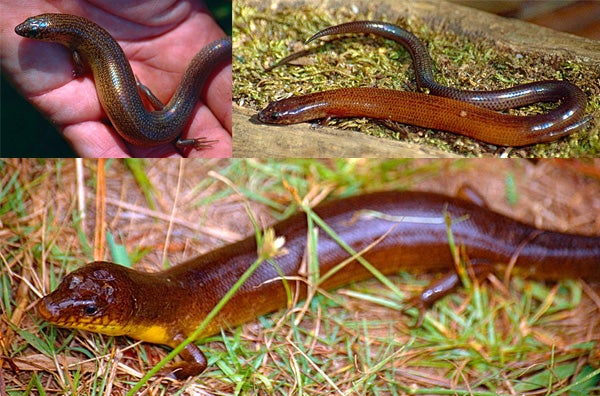
An Amphiglossus montage. Clockwise, from top left: A. anosyensis, A. sp. 'phaeurus' and A. astrolabi. All images CC BY-SA 2.0, by Bernard Dupont.
On supporting science journalism
If you're enjoying this article, consider supporting our award-winning journalism by subscribing. By purchasing a subscription you are helping to ensure the future of impactful stories about the discoveries and ideas shaping our world today.
Today we’re going to look briefly at one skink taxon in particular: the Madagascan Amphiglossus species. There are over 20 recognised species of Amphiglossus, and this is after a number of them have been removed and named as a distinct genus: Madascincus, named in 1981. Even with this revision, the group remains paraphyletic with respect to Androngo, Pygomeles and Voeltzkowia (Miralles et al. 2011). Several Amphiglossus skinks have been named in recent years and some have been discovered but are still awaiting formal description and naming. In general, these are cylindrical, shiny-scaled, blunt-headed skinks; they’re similar overall to their close relatives the Chalcides skinks (most of which are Eurasian).
A few things about the Amphiglossus species really catch my interest. One is they’re highly variable as goes their bodily proportions, vertebral count and limb form. Some are substantially longer-bodied than others (presacral vertebral count ranging from 30 to about twice that), and while some (e.g., A. reticulatus and A. frontoparietalis) have large, typical-looking limbs, others have tiny limbs where there might only be two digits (A. crenni) or even no digits at all (A. stylus, named in 2002). Incidentally, A. crenni is especially intriguing in that’s intraspecifically variable as goes digit count – most individuals only have two digits per limb, but some have as many as four (Glaw & Vences 2007).
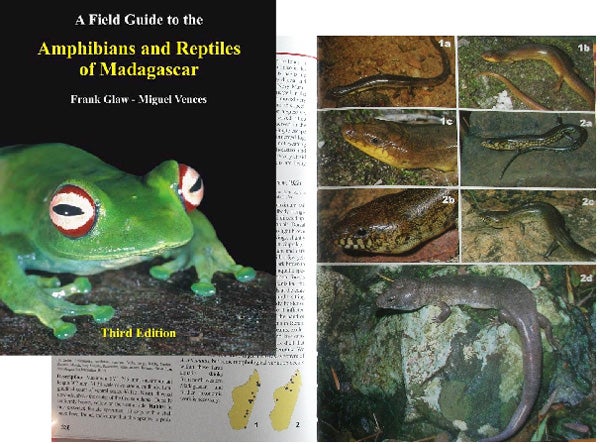
A reminder of how awesome Glaw & Vences (2007) is. The frog on the cover is Boophis luteus. The open pages show some of the Amphiglossus skinks; the big one at the bottom is A. reticulatus. Thanks once again to Neil Edmond for making my ownership of this book possible.
Another interesting thing is that they’re highly variable as goes ecology and behaviour. And, of all the things they do, one interests me in particular: in their outstanding and essential A Field Guide to the Amphibians and Reptiles of Madagascar, Glaw & Vences (2007) referred to the aquatic, stream-dwelling behaviour of the two large species A. reticulatus and A. astrolabi, and to their discovery of an A. reticulatus in a stream at night (see also Miralles et al. 2011). Nocturnal foraging is all over the place in tropical and subtropical squamates, but aquatic foraging is not especially common. And aquatic, nocturnal foraging is something very exciting (albeit not unprecedented: Lanthanotus).
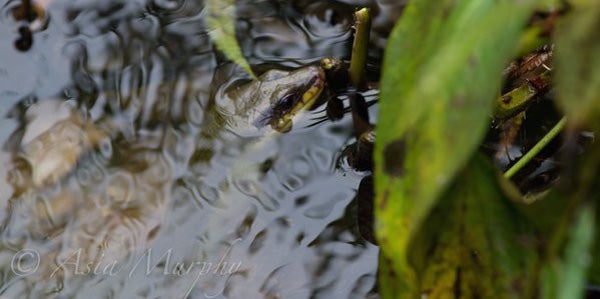
A. astrolabi, skulking in the water. Photo (c) Asia Murphy, used with permission.
With all of this in mind, I’m quite excited to share the set of photos you see here, taken by Virginia Polytechnic Institute and State University biologist Asia Murphy and used with her permission. The photos show a skulking, submerged Amphiglossus (I think A. astrolabi) grabbing and eating crabs!
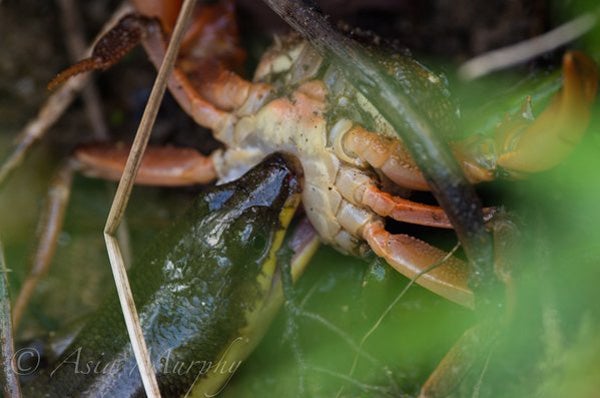
A. astrolabi vs crab. Photo (c) Asia Murphy, used with permission.
Crabs are highly abundant in some ecosystems (and not just in those associated with beaches, mangroves and tidal pools – there are enormous numbers of terrestrial crabs in some places as well), so it makes sense that adaptable predators like skinks might take advantage of them. But taking on crabs – comparatively big ones – is quite a big deal. I mean, a crab is a formidable and dangerous armour-plated beast, especially when you’re small. You would think that taking one on in a one-to-one battle might therefore require great strength (the ability to grab and disable the crab near-instantaneously, say), or great experience (the know-how to grab the crab in a ‘safe’ place where the pincers can’t reach you, say).
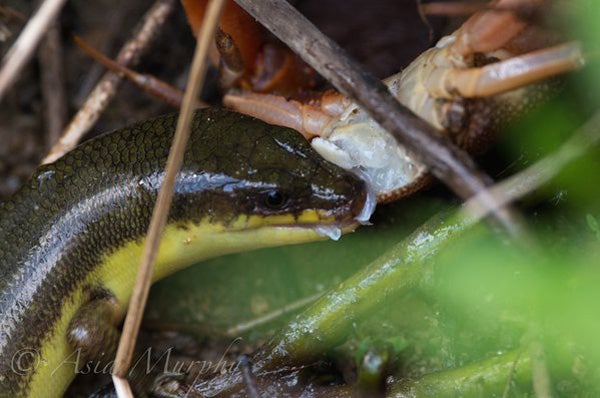
A. astrolabi, now dismembering the crab from its ventral surface. Photo (c) Asia Murphy, used with permission.
Both techniques have been evolved by squamates. The homalopsid snakes Fordonia and Gerarda (the former is popularly known as the crab-eating snake) both eat crabs and Fordonia will actually pin a crab down on the substrate before wrenching off and eating the legs, its unusual teeth and tough stomach lining being adaptations for this diet (Andrew Durso wrote much more about crab-eating snakes here).
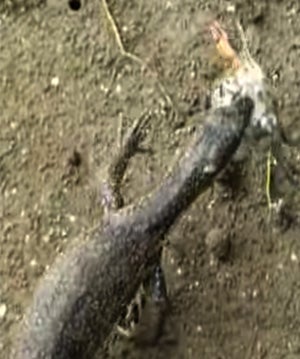
Screengrab from a segment of film (here) where a monitor leaves a burrow with an unfortunate crab. The monitor has either removed the crab's right pincer, or has it clamped in an immobile position against the crab's underside.
And lizards of several sorts – monitors and Galapagos lava lizards among them – sometimes eat crabs too, their technique mostly involving a quick grab followed by an attempt to ‘orally subdue’ the crab, sometimes with reckless attention to the position of the pincers. It isn’t difficult to find videos and images online of monitors eating crabs. But I can’t find a record of Amphiglossus doing this. Has Asia succeeded in documenting a first?
Thanks again to Asia Murphy for kindly providing the photos used here. More lizards here soon. And for previous Tet Zoo articles on skinks, see...
Refs - -